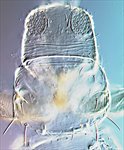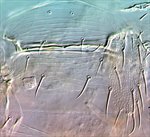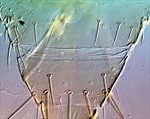
chrysis antenna

chrysis head & pronotum

chrysis meso & metanota

chrysis tergite VI

chrysis tergites VIII-IX
Generic diagnosis
Female micropterous. Head as long as wide; ocelli completely absent; maxillary palps 3-segmented; eyes without pigmented facets; ocellar setae pair I absent; pair III longer than II; six pairs of postocular setae close to eyes. Antennae 7-segmented; segment I without paired dorso-apical setae; III and IV with short forked sense-cones; II with a few microtrichia on dorsal surface, III–VI with microtrichial rows on both surfaces. Pronotum with little or no sculpture; two pairs of long posteroangular setae, two pairs of posteromarginal setae. Mesonotum transverse, median pair of setae near posterior margin; anteromedian campaniform sensilla present. Metanotum weakly reticulate; median pair of setae distant from anterior margin; campaniform sensilla absent. Fore wing lobe shorter than thorax width. Prosternal ferna weakly complete; basantra membranous, without setae; prospinasternum broad and transverse. Mesosternum with sternopleural sutures complete; endofurca with spinula. Metasternal endofurca without spinula. Tarsi 2-segmented. Tergites I–VIII with setae S1 long and extending to posterior margin on each tergite; setae S2 and S3 also long on II–VIII; ctenidia and craspeda absent; IX with anterior campaniform sensilla present; X with split complete. Sternites III–VII with three pairs of long marginal setae, II with two pairs; no discal setae or craspeda.
Biological data
Nothing is known of the biology of this thrips.
Distribution data
Know only from a single sample taken in southwestern China, Hengduan Mountains.
Nomenclatural data
Hengduanothrips Han & Cui, 1992: 427. Type species Hengduanothrips chrysis Han & Cui, 1992, by monotypy.
Only one species is placed in this genus (ThripsWiki, 2020), and this is known only from China:
chrysis Han & Cui, 1992: 427 (434)
Relationship data
Thripidae sub-family Thripinae: this is a diverse group involving more than 230 genera. Relationships of this monobasic genus are not clear. The absence of ocelli despite the presence of wing-lobes that bear setae is very unusual. The abdominal chaetotaxy, with three pairs of long tergal discal setae, is probably associated with extreme wing reduction. The species is possibly a wingless member of Thrips genus in which the tergal ctenidia are unusually reduced.
References
Han YF & Cui YQ (1992) Thysanoptera. pp. 420–434 in Insects of the Hengduan Mountains Region Vol.1
ThripsWiki (2020). ThripsWiki - providing information on the World's thrips. <http://thrips.info/wiki/Main_Page>